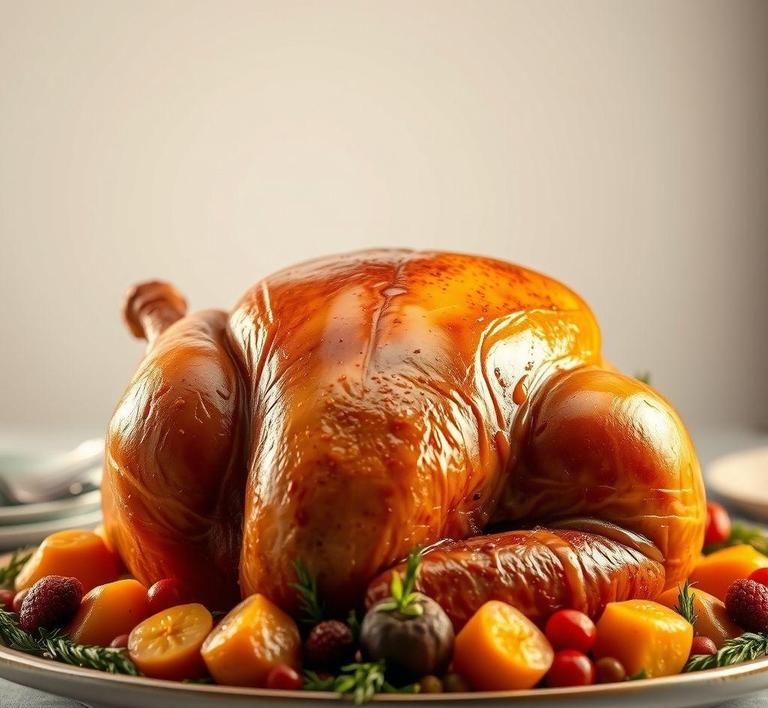So, you’ve found yourself with some leftover Butterball turkey and are wondering if you can safely refreeze it? Don’t worry, you’re not alone! Many people end up with more turkey than they can eat in one sitting, and the good news is that yes, you can refreeze your Butterball turkey-if done right. However, there are a few important things to keep in mind to ensure it stays safe and tasty. From proper storage methods to how long you can keep it in the freezer, this guide will walk you through everything you need to know to make the most of your turkey leftovers without compromising on flavor or quality.
Can You Refreeze Butterball Turkey?

Yes, you can refreeze a Butterball turkey-but with an important caveat: the turkey must have been thawed properly in the refrigerator and must not have reached room temperature for extended periods. This guideline aligns with USDA food safety recommendations and is especially pertinent when handling poultry, which is highly susceptible to bacterial growth.
If you’ve purchased a frozen Butterball turkey and then thawed it in the refrigerator (the only safe method approved for potential refreezing), and if you’ve decided not to cook it, you can safely place it back into the freezer. However, if the turkey was thawed using other methods-such as cold water thawing or microwave thawing-refreezing is not recommended unless it has been cooked first. These methods cause the turkey’s surface to warm to potentially unsafe temperatures, creating an environment conducive to bacterial proliferation.
How To Refreeze Butterball Turkey?
If you’ve confirmed your Butterball turkey was properly thawed in the refrigerator and hasn’t been sitting out for longer than two hours (or one hour if the ambient temperature is above 90°F/32°C), follow these careful steps to ensure safe refreezing:
- Inspect the Turkey: Ensure it’s still cold to the touch-ideally under 40°F. There should be no off smells, slimy texture, or discoloration. These are signs of spoilage, and if any are present, do not attempt to refreeze.
- Wrap It Tightly: Whether you’re refreezing a whole turkey or portions of one, proper wrapping is key. Use heavy-duty freezer wrap, vacuum seal, or tightly wrap with plastic wrap followed by aluminum foil to protect against freezer burn. Eliminate as much air as possible.
- Label with Date: Mark the package with the original thaw date and the refreeze date. This helps you track how long the turkey has been in storage. While frozen foods are safe indefinitely at 0°F, quality begins to degrade over time. It’s best to use refrozen turkey within 2-6 months for optimal taste and texture.
- Place in the Coldest Part of the Freezer: Store the turkey in the back or bottom of the freezer where the temperature remains the most stable. Avoid placing it in the freezer door, where temperatures fluctuate more frequently due to opening and closing.
If the turkey was cooked prior to the decision to refreeze, the process is even simpler-just allow the cooked meat to cool completely in the refrigerator (no more than two hours after cooking), then freeze in airtight containers or freezer-safe bags.
Quality Impact
While refreezing turkey is safe when done correctly, it does come at a cost-primarily in terms of texture and moisture content. Here’s how:
- Moisture Loss: Each freeze-thaw cycle results in a breakdown of cellular structures in the meat. As turkey thaws, water escapes from the muscle fibers, leading to drier meat upon cooking. This is especially noticeable with breast meat, which is leaner and more prone to drying out.
- Texture Changes: You may notice a slight mushiness or graininess in refrozen turkey, particularly in areas that were previously thawed and exposed to air. This is the result of ice crystal formation during the freezing process, which damages muscle tissues.
- Flavor Degradation: Although flavor is less impacted than texture, subtle changes can occur, especially if the turkey has not been well-wrapped. Oxidation and freezer burn (caused by air exposure) can give the turkey a stale or off-taste.
- Cooking Time Variations: A refrozen turkey may not cook as evenly as a freshly thawed one. Use a meat thermometer to ensure the thickest parts of the bird reach a safe internal temperature of 165°F (74°C).
To mitigate these quality losses, consider using refrozen turkey in soups, stews, casseroles, or shredded dishes where moisture can be reintroduced through broths or sauces.
Refreezing a Butterball turkey is entirely possible and safe-provided it was originally thawed in the refrigerator and has not been exposed to unsafe temperatures. While refreezing may lead to some decline in texture and flavor, careful handling and smart culinary choices can preserve much of its appeal.
When in doubt, rely on your senses and food safety guidelines: if it smells odd, looks discolored, or has an unusual texture, it’s better to discard it than risk illness. However, if stored correctly and used wisely, that refrozen turkey can still be the centerpiece of a delicious, hearty meal.
Is It Safe To Refreeze Butterball Turkey?
Yes, refreezing a Butterball turkey is generally safe-but only under specific conditions. The safety of refreezing meat, especially poultry like turkey, hinges largely on how it was handled during thawing and how long it remained at temperatures conducive to bacterial growth.
If your Butterball turkey was thawed in the refrigerator (the only USDA-recommended safe thawing method for potential refreezing), then you can safely refreeze it without cooking. The key here is temperature control: as long as the turkey remained at or below 40°F (4°C), bacteria would not have had the opportunity to multiply to dangerous levels.
However, if the turkey was thawed on the countertop, in warm water, or by using a microwave and left at room temperature for more than 2 hours (or 1 hour if the room temperature is above 90°F/32°C), it should not be refrozen. These methods can push the meat into the "danger zone" (between 40°F and 140°F), where bacteria like Salmonella and Campylobacter can thrive. Refreezing in this case only halts-but doesn’t destroy-bacterial activity, which may resume upon the next thaw and increase the risk of foodborne illness.
For cooked Butterball turkey, the same rules apply: ensure the meat hasn’t lingered in the danger zone. Cooked turkey can be safely refrozen if it has been properly refrigerated within two hours of cooking and hasn’t sat at room temperature.
Signs That Butterball Turkey Should Not Be Refrozen
It’s crucial to trust both your senses and knowledge of the turkey’s handling history. Here are the warning signs that indicate your Butterball turkey should not be refrozen:
- Off Odors: A sour, sulfurous, or putrid smell is an immediate red flag. Even if the meat looks fine, an unpleasant odor indicates bacterial growth and spoilage.
- Slimy or Sticky Texture: Fresh or safely thawed turkey should feel firm and slightly moist. A slimy, tacky surface often suggests the beginning stages of decomposition.
- Discoloration: Look out for grayish, green, or dull brown patches-particularly around the joints or on the skin. These color changes can signify spoilage.
- Room Temperature Exposure: If the turkey has been left out longer than 2 hours (or 1 hour in hot weather), it has likely entered the danger zone. Even if no visible spoilage signs are present, microbial contamination could have already taken hold.
- Unknown Thawing Conditions: If you’re unsure how the turkey was thawed (e.g., you received it from someone else or it was in your fridge longer than recommended), it’s best to err on the side of caution and avoid refreezing.
Common Refreezing Mistakes
Even well-meaning home cooks often make missteps when handling frozen poultry. Here are some common mistakes to avoid:
- Refreezing After Improper Thawing: Thawing in hot water, on the counter, or under running water and then refreezing is a big no-no. These methods can elevate internal temperatures and encourage bacterial growth.
- Ignoring the 2-Hour Rule: People often forget that perishable foods shouldn’t sit out longer than two hours. Extending this window, even slightly, can turn safe food into a risky gamble.
- Repeated Freezing and Thawing: Each freeze-thaw cycle damages the meat’s cellular structure, leading to loss of moisture, texture degradation, and flavor reduction. Repeating this process also increases the risk of contamination.
- Inadequate Packaging: If the turkey isn’t wrapped properly before refreezing, it can suffer from freezer burn. This leads to dry patches and tough, unappetizing meat.
- Freezing Cooked and Raw Meat Together: Combining cooked and raw turkey during freezing can lead to cross-contamination. Always store them separately and label clearly.
Tips And Tricks
To safely refreeze your Butterball turkey and preserve quality, here are several practical tips and best practices:
- Use Airtight Wrapping: Prevent freezer burn by tightly wrapping the turkey in plastic wrap, followed by aluminum foil or a freezer-safe zip-top bag. Vacuum sealing is even better.
- Label Everything: Always date your packages. Frozen turkey is best consumed within 2-6 months for optimal taste and texture.
- Divide into Portions: Rather than refreezing a whole bird or large cooked batch, divide into meal-sized portions. This not only speeds up thawing later but also minimizes future waste.
- Chill Before Freezing: If dealing with cooked turkey, let it cool completely before placing it in the freezer. Hot food can raise the freezer temperature and partially thaw surrounding items.
- Freeze as Soon as Possible: Don’t delay. The sooner you refreeze after determining it’s safe, the better the quality and safety of the turkey.
- Use a Thermometer: A refrigerator thermometer can help ensure your fridge stays at or below 40°F (4°C). An internal meat thermometer is invaluable for checking turkey during reheating or cooking.
Conclusion
Refreezing a Butterball turkey is entirely possible and safe-provided you follow strict food safety guidelines. The method of thawing, duration of exposure to room temperature, and the condition of the meat are all critical factors in determining whether refreezing is advisable.
Avoiding common mistakes like repeated thawing cycles or improper thawing techniques is essential not only for food safety but also for maintaining the turkey’s flavor and texture. Through smart handling-such as portioning, proper wrapping, and labeling-you can extend the usability of your Butterball turkey without compromising quality.
Remember, when in doubt, throw it out. A delicious holiday meal or weeknight dinner is never worth risking a bout of foodborne illness. Keep your kitchen practices sharp and your freezer savvy, and you’ll enjoy your Butterball turkey safely and deliciously-every time.


